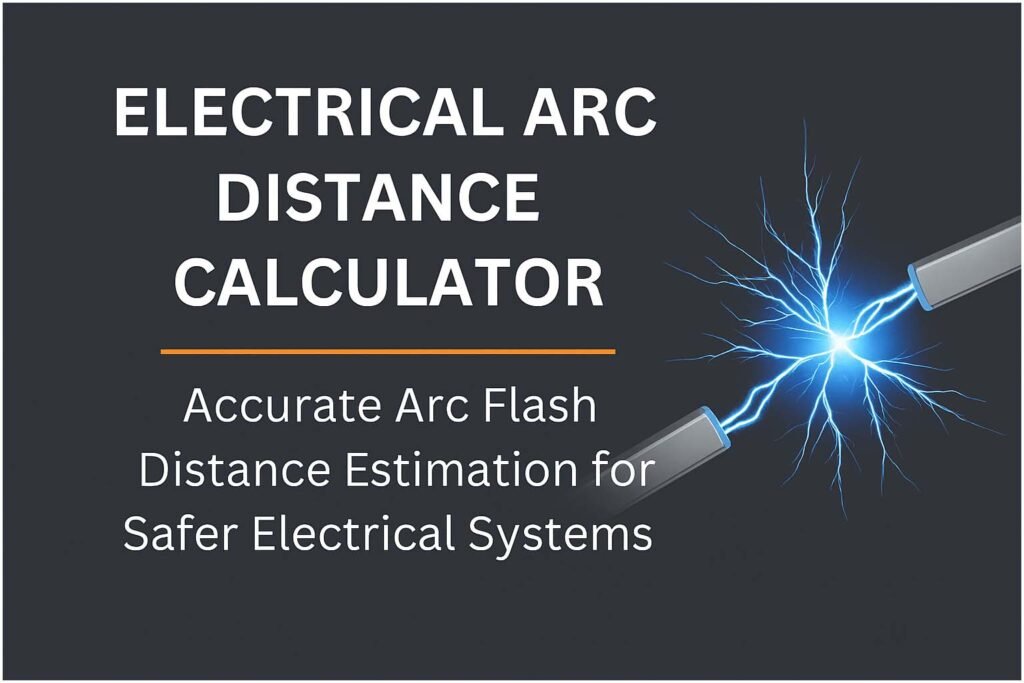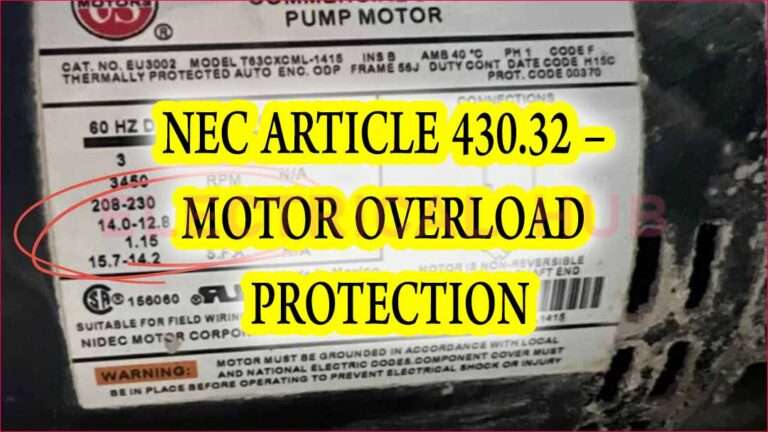Electrical Arc Distance Calculator: Accurate Arc Flash Distance Estimation for Safer Electrical Systems
An electrical arc distance calculator is a practical tool used to estimate how far an arc flash can travel when a fault occurs in an electrical system. Arc flashes happen when current jumps across gaps in conductors. They produce extreme heat, pressure waves, and intense light. This event can seriously injure anyone standing near the equipment. Understanding arc distance helps determine safe work boundaries, PPE requirements, and system design decisions.

Table of Contents
Arc flash calculations are often part of broader electrical safety practices. Engineers, facility managers, and electricians rely on tools that predict arc flash boundaries and incident energy levels. The electrical arc distance calculator simplifies this process. Instead of running full engineering software for every task, the calculator allows users to input basic system values and receive clear results on potential arc reach and hazard zones.
The accuracy of these calculators depends on data inputs. Still, they serve as a fast and reliable way to estimate risks and to plan electrical safety procedures. They are also widely used during routine inspections, system upgrades, and safety training. Access our powerful online calculator now Electrical Diversity Calculator for accurate Load Estimation and efficient electrical Design.
Why Electrical Arc Distance Matters
Electrical arcs are unpredictable. They can erupt in a split second when insulation breaks down or when conductive dust, moisture, or equipment failure creates a bridge for current flow. The arc can travel several feet depending on voltage, system configuration, and fault current.
An electrical arc distance calculator helps professionals identify three main safety boundary types:
- The arc flash protection boundary
- The limited approach boundary
- The restricted approach boundary
These boundaries define how close a person can stand without high risk of injury. They also determine what level of personal protective equipment is required. Without calculations, workers may underestimate how far dangerous energy can travel.
A simple rule of thumb never works for arc flash analysis. Voltages above 480V, high available fault currents, and longer clearing times can increase the distance dramatically. Calculators solve this by incorporating mathematical models from standards such as NFPA 70E and IEEE 1584. Make your task simple with our online tool electrical cable size calculator
Key Inputs Used in Electrical Arc Distance Calculators
A typical electrical arc distance calculator requests a set of common electrical values. These inputs drive the formulas that estimate arc boundaries and incident energy. The table below shows the main inputs used in most calculators.
Common Input Parameters
| Parameter | Description | Why It Matters |
|---|---|---|
| System Voltage (V) | Voltage level of the equipment | Higher voltage increases arc travel potential |
| Available Fault Current (kA) | Maximum current available during a fault | Drives arcing current and heat release |
| Clearing Time (seconds) | Time taken by protective devices to interrupt the fault | Longer clearing time increases arc energy |
| Equipment Type | Switchgear, MCC, panelboard, etc. | Geometry and enclosure size change arc behavior |
| Working Distance | Distance between worker and arc source | Determines incident energy at worker’s location |
These parameters feed into standard equations that estimate arc flash boundary distances. Calculators streamline this process with automated computations.
How the Electrical Arc Distance Calculator Works
The electrical arc distance calculator uses mathematical models to estimate how far an arc flash can travel. It typically applies one of two methods:
IEEE 1584 Model
This method is widely used for modern electrical systems. It includes factors such as:
- Electrode configuration
- Enclosure size
- System grounding
- Arcing current correction factors
It provides more accurate results for most equipment types from 208V up to 15kV. Explore our professional online tool for quick calculations kw to cable size calculator
NFPA 70E Simplified Equations
These are used when limited system data is available or when working on simple systems. They offer conservative values to ensure safety.
In both methods, the calculator processes the input data and produces two main results:
- Arc Flash Boundary – the minimum safe distance from arc exposure
- Incident Energy – energy released at a specific working distance
Both values are critical for planning safe electrical work.
Where Electrical Arc Distance Calculators Are Used
Electrical arc distance calculators are used across various industries. Any facility with electrical distribution equipment benefits from these calculations. Common use cases include:
- Industrial plants
- Commercial buildings
- Data centers
- Power generation sites
- Oil and gas facilities
- Utility operations
Engineers use calculators during electrical system design. Maintenance teams use them during routine work to confirm safe distances. Safety officers use calculators during arc flash labeling and risk assessments.
The calculator supports compliance with NFPA 70E, OSHA, and IEEE 1584 standards. These regulations require employers to identify arc flash hazards and protect workers from electrical risks. Experience fast and accurate results using our online tool cable size calculator uk
Sample Arc Distance Estimates
Below is a simple example showing how various input conditions affect arc distance. These values are approximations, not final engineering results.
Example Arc Flash Boundary Table
| Voltage Level | Fault Current | Clearing Time | Estimated Arc Boundary |
|---|---|---|---|
| 480V | 25 kA | 0.03 s | 3–5 feet |
| 480V | 40 kA | 0.10 s | 6–9 feet |
| 13.8 kV | 20 kA | 0.20 s | 10–20 feet |
| 13.8 kV | 40 kA | 0.30 s | 20–35 feet |
This shows how higher fault currents and longer clearing times increase arc travel distance. Calculate instantly with our smart online tool cable size calculator australia
Benefits of Using an Electrical Arc Distance Calculator
There are several advantages to using these calculators during safety planning.
Fast Estimations
Calculators deliver immediate results. This is especially useful during field inspections or quick evaluations when full arc flash studies are unavailable.
Improved Safety
Accurate arc distance values help protect workers. Proper boundary labeling and PPE selection depend on precise calculations.
Supports Compliance
Many regulations require arc flash analysis. The calculator helps facilities meet compliance without delay.
Cost Efficiency
Quick calculations reduce downtime and prevent costly over-estimation or under-estimation of hazard boundaries.
Helps During System Changes
When equipment is upgraded or operating conditions change, calculators provide updated safety distances without running a full study. Start using our easy-to-use online tool earthing cable size calculator
Tips for Using an Electrical Arc Distance Calculator Effectively
To get the most accurate results, follow these best practices:
- Use verified electrical data from system studies or utility sources
- Enter correct equipment type and electrode configuration
- Avoid guessing fault current values
- Review protective device clearing times from breaker or relay settings
- Compare calculator results with NFPA 70E arc flash tables if needed
- Treat the results as guidance when full studies are not available
Accurate inputs lead to trustworthy outputs.
When You Should Not Rely Only on a Calculator
A standalone electrical arc distance calculator is ideal for quick assessments, but it should not replace a full arc flash study when:
- The facility has complex distribution systems
- Multiple voltage levels exist in one area
- Protective device coordination requires detailed modeling
- Calculations must be placed on official arc flash labels
- The system uses high-voltage switchgear
- Insurers or regulators require a full engineering analysis
In those cases, advanced software and detailed system modeling are required. Get instant results with our online tool earth cable size calculator
Conclusion
An electrical arc distance calculator is an essential tool for electrical safety. It helps estimate how far an arc flash can travel and how much energy may reach workers during a fault. With simple inputs like voltage, fault current, and clearing time, the calculator provides fast results that support safe operations. It is widely used in industries that rely on electrical systems and plays a key role in meeting safety standards. Use our online tool 3 phase cable size calculator
Using this calculator improves hazard awareness, strengthens safety culture, and reduces the risk of injury. While not a replacement for full arc flash studies in complex environments, it remains one of the most effective tools for quick and reliable arc flash assessments.
Follow Us on Social:
Subscribe our Newsletter on Electrical Insights to get the latest updates in Electrical Engineering.
#ElectricalArcDistanceCalculator, #ArcFlashSafety, #ElectricalSafetyTools, #ArcFlashCalculator, #ElectricalEngineering, #IndustrialSafety, #ArcDistanceFormula, #ArcFlashRiskAssessment, #ElectricalProtection, #SafetyCompliance





